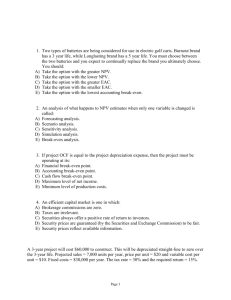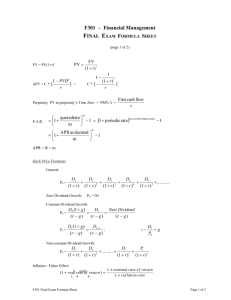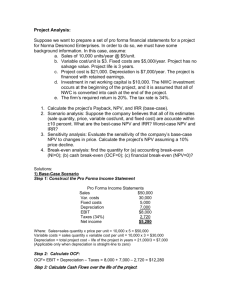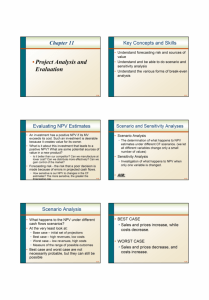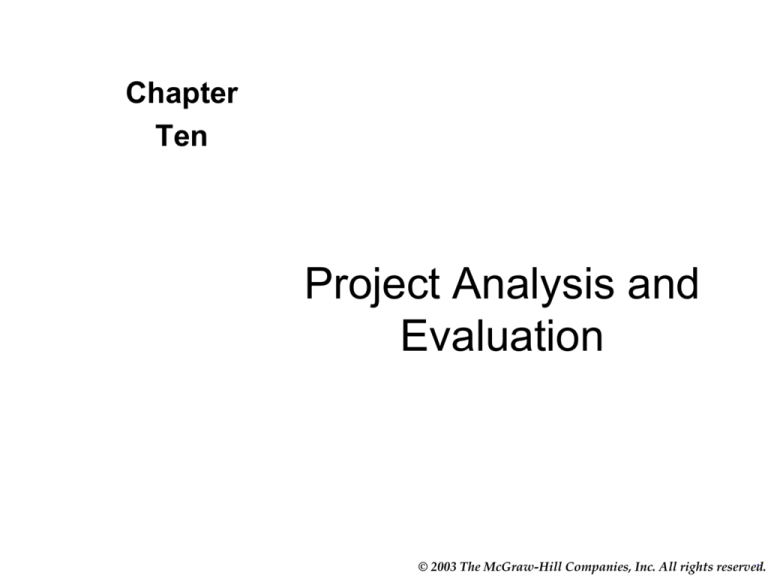
Chapter
Ten
Project Analysis and
Evaluation
.
© 2003 The McGraw-Hill Companies, Inc. All rights reserved.
Chapter Outline
•
•
•
•
Evaluating NPV Estimates
Scenario and Other What-If Analyses
Break-Even Analysis
Operating Leverage
1
.
Evaluating NPV Estimates
• NPV estimates are just that – estimates
• A positive NPV is a good start – now we need to
take a closer look at:
– Forecasting risk – how sensitive is our NPV to
changes in the cash flow estimates; the discount
rate, etc.
• What about the sales forecast?
• Can be manufactured at lower costs?
• What about the discount rate?
– Sources of value – why does this project create
value?
2
.
10-2 sensitivity analysis
• Types of Analysis
• Sensitivity
• Analyzes effects of changes in sales, costs, etc., on
project
• Scenario
• Project analysis given particular combination of
assumptions
• Simulation
• Estimates probabilities of different outcomes
• Break Even
• Level of sales (or other variable) at which project
breaks even
.
Sensitivity Analysis
• What happens to NPV when we vary one
variable at a time?
• The greater the volatility in NPV in relation to a
specific variable, the larger the forecasting risk
associated with that variable
• Sensitivity analysis begins with a base-case
situation.
• Then answer “what if” questions, e.g. “What if
sales decline by 10%?”
4
.
Net Cash Flows Example
Year 0
Init. Cost
At 10%
Year 3
Year 4
0
0
0
0
0
$106,680
$120,450
$93,967
$88,680
-$30,000
-$900
-$927
-$956
$32,783
0
0
0
0
$15,000
-$270,000
$105,780
$119,523
$93,011
$136,463
Salvage CF
Net CF
Year 2
-$240,000
Op. CF
NWC CF
Year 1
NPV=
88k
.
Sensitivity Analysis,
Change from
Base Level
-30%
-15%
0%
15%
30%
Resulting NPV (000s)
r
Unit Sales Salvage
10%
1250
$25000
$113
$100
$88
$76
$65
$17
$52
$88
$124
$159
$85
$86
$88
$90
$91
.
NPV
(000s)
Unit Sales
Salvage
88
r
-30
-20
-10 Base 10
Value
20
30
(%)
.
Results of Sensitivity Analysis
• Steeper sensitivity lines show greater risk.
That means small % changes in an input
variable result in large changes in NPV.
• Unit sales line is steeper than salvage value
or ‘r’ lines,
• For this project, we should worry most about
the accuracy of sales forecast.
.
Advantages - Disadvantages
• Advantages:
– Gives some idea of stand-alone risk.
– Identifies ‘dangerous’ variables.
– Gives some breakeven information.
• Disadvantage:
– Ignores relationships among variables.
.
Scenario Analysis
• What happens to the NPV under different cash
flow scenarios?
• At the very least look at:
– Best case – high revenues, low costs
– Worst case – low revenues, high costs
– Measure of the range of possible outcomes
• Best case and worst case are not necessarily
probable, but they can still be possible
• Provides a range of possible outcomes.
10
.
Scenario Analysis - Example
• Best scenario: 1,600 units @ $240
Worst scenario: 900 units @ $160
Scenario
Best
Base
Worst
Probability
0.25
0.50
0.25
E(NPV) = $101.5
(NPV) = 75.7
CV(NPV) = (NPV)/E(NPV) =
NPV(000)
$ 279
88
-49
0.75
.
Advantages - Disadvantages
• Advantages:
• More realistic than sensitivity analysis.
• Disadvantages:
• Only considers a few possible outcomes.
• Assumes that inputs are perfectly correlated-all “bad” values occur together and all “good”
values occur together.
.
Simulation Analysis
• Simulation is really just an expanded sensitivity
and scenario analysis
• Simulation can estimate thousands of possible
outcomes quickly:
– Variables are defined with probability distributions,
for example a normal distribution for sales.
– Computer selects values for each variable based on
given probability distributions for each “run” and
the NPV is calculated.
– Process is repeated many times (in 1,000’s).
13
.
Simulation Example
• Assume:
– Normal distribution for unit sales:
•Mean = 1,250
•Standard deviation = 200
– Triangular distribution for unit price:
•Lower bound = $160
•Most likely
= $200
•Upper bound = $250
.
Simulation Process
• Pick a random variable for unit sales and sale
price.
• Substitute these values in the spreadsheet and
calculate NPV.
• Repeat the process many times, saving the input
variables (unit sales and price) and the output
(NPV).
• Display the NPV values in graphical format, verify
the probabiliy of ending up with negative NPVs.
.
Histogram of Results
Probability
-$60,000
$45,000
$150,000
$255,000
$360,000
NPV ($)
.
Break-Even Analysis
• The crucial variable for a project is sales volume.
• Break-even analysis is a common tool for analyzing the
relationship between sales volume and profitability
• There are various break-even measures
– Financial break-even –> sales volume at which NPV= 0
– Accounting break-even –> sales volume at which net
income = 0
• Goal: How bad do sales have to get before we actually begin
to lose money?
17
.
Example
• Consider the following Project:
– A new product requires an initial investment of $5
million and will be depreciated to an expected book
value of zero over 5 years
– The price of the new product is expected to be $25,000
and the variable cost per unit is $15,000
– The fixed cost is $1 million. Tax rate = 0.3
– If we assume that we can sell 300 units each year,
what would be the NPV? (discount rate 20%)
• EBIT= [(P-v)Q – FC – D]= (10,000)300 –1,000,000 –1,000,000 =
1,000,000
• OCF = EBIT (1-T)+ D = 1,000,000 (0.7)+1,000,000 = 1,700,000
• NPV = -5,000,000 + 1,700,000 (PVAF 5-yr, @20%) =
• NPV = -5,000,000 + 1,700,000 (3) = 100,000$
18
.
Ex: Financial Break-Even Analysis
• Question: At which sales level ‘NPV = 0’?
CF stream:
5,000,000 OCF OCF OCF OCF OCF
NPV = 0= -5,000,000 + OCF [PVAF 5y; 20%]=
5,000,000 = OCF (3)
OCF = 1,672,240
OCF = 1,672,240= NI+D ; NI= 672,240 $
NI= 672,240= [(P-v)Q-FC-D]=10,000Q–1,000,000–1,000,000
10,000Q = 672,240+2,000,000
Q=267.2units
19
.
Accounting Break-Even
• The quantity that leads to a zero net income.
• Project Net Income set equal to 0:
• NI => (Sales – VC – FC – D)(1 – T) = 0
• Divide both sides by (1-T), when NI is zero, so is
the pre-tax income:
• [Sales - VC - FC – D] = 0
• Sales - VC = FC + D
• (QP – vQ) = FC + D
• Q = (FC + D) / (P – v)
20
.
Ex: Accounting break-even each year?
Depreciation = 5,000,000 / 5 = 1,000,000
Q = (FC + D) / (P – v)
Q = (1,000,000 + 1,000,000)/(25,000 – 15,000) = 200 units
• Verify EBIT and OCF at Q=200
EBIT= [(P-v)Q – FC – D]= (10,000)200 – 1,000,000 – 1,000,000 = 0
OCF= EBIT + D = 0 +1,000,000 = 1,000,000
NPV = -5,000,000 + 1,000,000 (3) = -2,000,000
• Observations:
• If a firm just breaks even on an accounting basis, NPV < 0
• If a firm just breaks even on an accounting basis, OCF = Depr
.
Using Accounting Break-Even
• Easy to calculate
• Accounting break-even is often used as an early
stage screening number
• If a project cannot break even on an accounting
basis, then it is not going to be a worthwhile
project
• Accounting break-even gives managers an
indication of how a project will impact accounting
profit
22
.
Summary table(in 000s except Q)
Q= 200
Q= 267,2
Sales
FC
VC
Depr
5,000
6,680
1,000
1,000
3,000
4,008
1,000
1,000
EBIT
0
672
TAXES
0
0
NI
0
672
OCF=NI+Depr
1,000
1,672
NPV
-2,000
0
Account B_E
Financial B_E
.
Operating Leverage
• Operating leverage is the degree to which a
project/firm is committed to fixed production
costs.
• Heavy investment in plant equipment means high
degree of operating leverage
• Such projects are said to be capital intensive.
24
.
Operating Leverage
• One way of measuring operating leverage:
• How much % change in OCF occurs for a %
change in sales.
• % change in OCF= DOL x % change in Q
• ‘Degree of operating leverage’ (DOL):
• DOL = 1 + (FC / OCF)
– The higher the fixed costs, the higher the DOL
– The higher the DOL, the greater the variability in
operating cash flow
25
.
Example: DOL
• Consider the previous example
• Suppose sales are 300 units
– This meets all three break-even measures
– What is the DOL at this sales level?
– OCF = 1,700,000
– DOL = 1 + 1,000,000 / 1,700,000 = 1.59
• What will happen to OCF if unit sales increases by 1%?
– % change in OCF
= DOL* % change in Q
– % change
= 1.59*(1%) = 1.59%
– New OCF
= 2,000,000(1.0159) =2,031,800
26
.
Financial Break-Even Analysis with taxes
Let us solve the financial break-even problem with taxes.
What OCF (or payment) makes NPV = 0?
Actually OCF does not change, let us see:
PV = 5,000,000= OCF [PVAF 5-7;20%]= OCF (2.99)
OCF = 1,672,240
However, the break-even quantity will change:
OCF = [(P-v)Q – FC – D](1-T) + D=
OCF=(P-v)Q(1-T) – (FC + D)(1-T) + D
Q= OCF+[(FC+D)(1-T)-D] / (P-v)(1-T)
Q=(1672240+(2000.000)0.7 - 1000.000)) + 10000)0.7
Q= (1672240+400.000) / 7000 = 296
The question now becomes: Can we sell at least 296 units per year?
27
.

